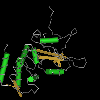?
 
Src homology 2 (SH2) domain found in signal transducer and activator of transcription (STAT) 1 proteins STAT1 is a member of the STAT family of transcription factors. STAT1 is involved in upregulating genes due to a signal by interferons. STAT1 forms homodimers or heterodimers with STAT3 that bind to the Interferon-Gamma Activated Sequence (GAS) promoter element in response to IFN-gamma stimulation. STAT1 forms a heterodimer with STAT2 that can bind Interferon Stimulated Response Element (ISRE) promoter element in response to either IFN-alpha or IFN-beta stimulation. Binding in both cases leads to an increased expression of ISG (Interferon Stimulated Genes). STAT1 has been shown to interact with protein kinase R, Src, IRF1, STAT3, MCM5, STAT2, CD117, Fanconi anemia, complementation group C, CREB-binding protein, Interleukin 27 receptor, alpha subunit, PIAS1, BRCA1, Epidermal growth factor receptor, PTK2, Mammalian target of rapamycin, IFNAR2, PRKCD, TRADD, C-jun, Calcitriol receptor, ISGF3G, and GNB2L1. STAT proteins mediate the signaling of cytokines and a number of growth factors from the receptors of these extracellular signaling molecules to the cell nucleus. STATs are specifically phosphorylated by receptor-associated Janus kinases, receptor tyrosine kinases, or cytoplasmic tyrosine kinases. The phosphorylated STAT molecules dimerize by reciprocal binding of their SH2 domains to the phosphotyrosine residues. These dimeric STATs translocate into the nucleus, bind to specific DNA sequences, and regulate the transcription of their target genes. However there are a number of unphosphorylated STATs that travel between the cytoplasm and nucleus and some STATs that exist as dimers in unstimulated cells that can exert biological functions independent of being activated. There are seven mammalian STAT family members which have been identified: STAT1, STAT2, STAT3, STAT4, STAT5 (STAT5A and STAT5B), and STAT6. There are 6 conserved domains in STAT: N-terminal domain (NTD), coiled-coil domain (CCD), DNA-binding domain (DBD), alpha-helical linker domain (LD), SH2 domain, and transactivation domain (TAD). NTD is involved in dimerization of unphosphorylated STATs monomers and for the tetramerization between STAT1, STAT3, STAT4 and STAT5 on promoters with two or more tandem STAT binding sites. It also plays a role in promoting interactions with transcriptional co-activators such as CREB binding protein (CBP)/p300, as well as being important for nuclear import and deactivation of STATs involving tyrosine de-phosphorylation. CCD interacts with other proteins, such as IFN regulatory protein 9 (IRF-9/p48) with STAT1 and c-JUN with STAT3 and is also thought to participate in the negative regulation of these proteins. Distinct genes are bound to STATs via their DBD domain. This domain is also involved in nuclear translocation of activated STAT1 and STAT3 phosphorylated dimers upon cytokine stimulation. LD links the DNA-binding and SH2 domains and is important for the transcriptional activation of STAT1 in response to IFN-gamma. It also plays a role in protein-protein interactions and has also been implicated in the constitutive nucleocytoplasmic shuttling of unphosphorylated STATs in resting cells. The SH2 domain is necessary for receptor association and tyrosine phosphodimer formation. Residues within this domain may be particularly important for some cellular functions mediated by the STATs as well as residues adjacent to this domain. The TAD interacts with several proteins, namely minichromosome maintenance complex component 5 (MCM5), breast cancer 1 (BRCA1) and CBP/p300. TAD also contains a modulatory phosphorylation site that regulates STAT activity and is necessary for maximal transcription of a number of target genes. The conserved tyrosine residue present in the C-terminus is crucial for dimerization via interaction with the SH2 domain upon the interaction of the ligand with the receptor. STAT activation by tyrosine phosphorylation also determines nuclear import and retention, DNA binding to specific DNA elements in the promoters of responsive genes, and transcriptional activation of STAT dimers. In addition to the SH2 domain there is a coiled-coil domain, a DNA binding domain, and a transactivation domain in the STAT proteins. In general SH2 domains are involved in signal transduction. They typically bind pTyr-containing ligands via two surface pockets, a pTyr and hydrophobic binding pocket, allowing proteins with SH2 domains to localize to tyrosine phosphorylated sites. |
